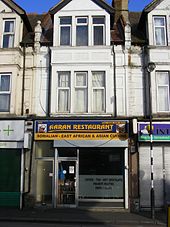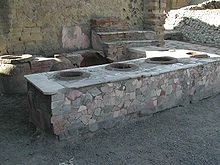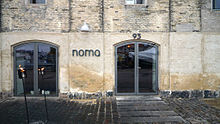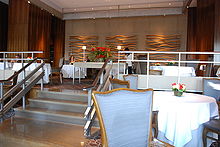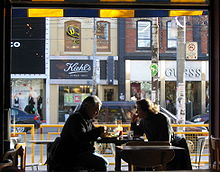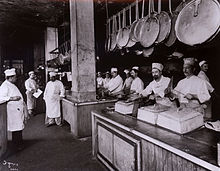Restaurant
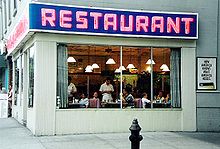
Earls Restaurants History
Stan Fuller, CEO of earls Restaurants talks about his father (and founder), Leroy Earl Fuller’s Empire and the path leading up to it from over 25 years ago to now. What a story!
Tom’s Restaurant in Manhattan was made internationally famous by Seinfeld
A restaurant (/ˈrɛstərənt/ or /ˈrɛstərɒnt/; French: [ʀɛs.to.ʁɑ̃] (![]() listen)) is a business establishment which prepares and serves food and drink to customers in return for money, either paid before the meal, after the meal, or with a running tab. Meals are generally served and eaten on premises, but many restaurants also offer take-out and food delivery services. Restaurants vary greatly in appearance and offerings, including a wide variety of the main chef’s cuisines and service models.
listen)) is a business establishment which prepares and serves food and drink to customers in return for money, either paid before the meal, after the meal, or with a running tab. Meals are generally served and eaten on premises, but many restaurants also offer take-out and food delivery services. Restaurants vary greatly in appearance and offerings, including a wide variety of the main chef’s cuisines and service models.
Types
Restaurants on Greek islands are often situated directly on the beach. This is an example from Astypalaia.
Restaurants may be classified or distinguished in many different ways. The primary factors are usually the food itself (e.g. vegetarian, seafood, steak); the cuisine (e.g. Italian, Chinese, Indian, French, Thai) and/or the style of offering (e.g. tapas bar, asushi train, a tastet restaurant, a buffet restaurant or a yum cha restaurant). Beyond this, restaurants may differentiate themselves on factors including speed (see fast food), formality, location, cost, service, or novelty themes, such as automated restaurants.
Restaurants range from inexpensive and informal lunching or dining places catering to people working nearby, with simple food served in simple settings at low prices, to expensive establishments serving refined food and fine wines in a formal setting. In the former case, customers usually wear casual clothing. In the latter case, depending on culture and local traditions, customers might wear semi-casual, semi-formal, or formal wear. Typically, customers sit at tables, their orders are taken by a waiter, who brings the food when it is ready, and the customers pay the bill before leaving.
A Somali restaurant in the London Borough of Waltham Forest
For some time the travelling public has been catered for with ship’s messes and railway restaurant cars which are, in effect, travelling restaurants. (Many railways, the world over, also cater for the needs of travellers by providing Railway Refreshment Rooms [a form of restaurant] at railway stations.) In recent times there has been a trend to create a number of travelling restaurants, specifically designed for tourists. These can be found on such diverse places as trams, boats, buses, etc.
Restaurant staff
A restaurant’s proprietor is called a restaurateur /ˌrɛstərəˈtɜr/; like ‘restaurant’, this derives from the French verb restaurer, meaning “to restore”. Professional cooks are called chefs, with there being various finer distinctions (e.g. sous-chef, chef de partie). Most restaurants (other than fast food restaurants) will have various waiting staff; in finer restaurants this may include a host or hostess or even a maître d’hôtel to welcome customers and to seat them, together with a busboy and sommelier.
Chefs working in a restaurant kitchen at Sugar Street, Causeway Bay, Hong Kong
History – Rome
In Ancient Rome, thermopolia (singular thermopolium) were small restaurant-bars that offered food and drinks to customers. A typical thermopolium had L-shaped counters into which large storage vessels were sunk, which would contain either hot or cold food. They are linked to the absence of kitchens in many dwellings and the ease with which people could purchase prepared foods. Furthermore, eating out was considered an important aspect of socialising.
A Roman Thermopolium in Pompeii.
In Pompeii, 158 thermopolia with a service counter have been identified across the whole town area. They were concentrated along the main axis of the town and the public spaces where they were frequented by the locals.
China
In China, food catering establishments which may be described as restaurants were known since the 11th century in Kaifeng, China’s northern capital during the first half of the Song Dynasty (960–1279). With a population of over 1,000,000 people, a culture of hospitality and a paper currency, Kaifeng was ripe for the development of restaurants. Probably growing out of the tea houses and taverns that catered to travellers, Kaifeng’s restaurants blossomed into an industry catering to locals as well as people from other regions of China. Stephen H. West argues that there is a direct correlation between the growth of the restaurant businesses and institutions of theatrical stage drama, gambling and prostitution which served the burgeoning merchant middle class during the Song Dynasty. Restaurants catered to different styles of cuisine, price brackets, and religious requirements. Even within a single restaurant much choice was available, and people ordered the entree they wanted from written menus. An account from 1275 writes of Hangzhou, the capital city for the last half of the dynasty:
“The people of Hangzhou are very difficult to please. Hundreds of orders are given on all sides: this person wants something hot, another something cold, a third something tepid, a fourth something chilled; one wants cooked food, another raw, another chooses roast, another grill.”
The restaurants in Hangzhou also catered to many northern Chinese who had fled south from Kaifeng during the Jurcheninvasion of the 1120s, while it is also known that many restaurants were run by families formerly from Kaifeng.
Western world
In the Western world, while inns and taverns were known from antiquity, these were establishments aimed at travelers, and in general locals would rarely eat there. The modern idea of a restaurant – as well as the term itself – appeared in Paris around 1765 when Boulanger began to sell “restorants” and other foods:
“Restaurants constituted another sort [of eating establishment], a new one if we define them as places where one can order a meal from a range of choices at a range of times and eat it on the premises. About 1765, people rounding the corner of the rue Bailleul and the rue des Poulies, just a few blocks east of the Café de la Régence, passed by the innovator’s sign: “Boulanger débite des restaurants divins” (Boulanger sells divine restaurants). Boulanger was originally a soup vendor and certain soups were known as restaurants—literally, “restoratives.” The Encyclopédie defined restaurant as “a medical term; it is a remedy whose purpose is to give strength and vigor.” Thanks to Boulanger and his imitators, these soups moved from the category of remedy into the category of health food and ultimately into the category of ordinary food….Almost forgotten in the spread of restaurants was the fact that their existence was predicated on health, not gustatory, requirements.”
United States
In the United States it was not until the late 18th century that establishments that provided meals without also providing lodging began to appear in major metropolitan areas in the form of coffee and oyster houses. The actual term “restaurant” did not enter into the common parlance until the following century. Prior to being referred to as “restaurants” these eating establishments assumed regional names such as “eating house” in New York City, “restorator” in Boston, or “victualing house” in other areas. Restaurants were typically located in populous urban areas during the 19th century and grew both in number and sophistication in the mid-century due to a more affluent middle class and to suburbanization. The highest concentration of these restaurants were in the West, followed by industrial cities on the Eastern Seaboard, with the lowest number of restaurants per person located in the southern states.
Guides
Noma in Copenhagen, Denmark rated 2 stars in the Michelin guide, and named Best Restaurant in the World by Restaurant.
Restaurant guides review restaurants, often ranking them or providing information for consumer decisions (type of food, handicap accessibility, facilities, etc.). One of the most famous contemporary guides is the Michelin series of guides which accord from 1 to 3 stars to restaurants they perceive to be of high culinary merit. Restaurants with stars in the Michelin guide are formal, expensive establishments; in general the more stars awarded, the higher the prices.
The main competitor to the Michelin guide in Europe is the guidebook series published by Gault Millau. Unlike the Michelin guide which takes the restaurant décor and service into consideration with its rating, Gault Millau only judges the quality of the food. Its ratings are on a scale of 1 to 20, with 20 being the highest.
In the United States, the Forbes Travel Guide (previously the Mobil travel guides) and the AAA rate restaurants on a similar 1 to 5 star (Forbes) or diamond (AAA) scale. Three, four, and five star/diamond ratings are roughly equivalent to the Michelin one, two, and three star ratings while one and two star ratings typically indicate more casual places to eat. In 2005, Michelin released a New York City guide, its first for the United States. The popular Zagat Survey compiles individuals’ comments about restaurants but does not pass an “official” critical assessment. In the United States Gault Millau is published as the Gayot guide, after founder André Gayot. Its restaurant ratings use the same 20 point system, and are all published online.
Per Se, in New York City, has three Michelin stars and is rated at or near the top of multiple Zagat lists.
The Good Food Guide, published by the Fairfax Newspaper Group in Australia, is the Australian guide listing the best places to eat. Chefs Hats are awarded for outstanding restaurants and range from one hat through three hats. The Good Food Guide also incorporates guides to bars, cafes and providers. The Good Restaurant Guide is another Australian restaurant guide that has reviews on the restaurants as experienced by the public and provides information on locations and contact details. Any member of the public can submit a review.
Nearly all major American newspapers employ food critics and publish online dining guides for the cities they serve. Some news sources provide customary reviews of restaurants, while others may provide more of a general listings service.
More recently Internet sites have started up that publish both food critic reviews and popular reviews by the general public.
Economics
Many restaurants are small businesses, and franchise restaurants are common. There is often a relatively large immigrant representation, reflecting both the relatively low start-up costs of the industry (thus making restaurant ownership an option for immigrants with relatively few resources) and the cultural importance of food.
Canada
There are 86,915 commercial foodservice units in Canada, or 26.4 units per 10,000 Canadians. By segment, there are:
- 38,797 full-service restaurants
- 34,629 limited-service restaurants
- 741 contract and social caterers
- 6,749 drinking places
Fully 63% of restaurants in Canada are independent brands. Chain restaurants account for the remaining 37%, and many of these are locally owned and operated franchises.
European Union
The EU-27 has an estimated 1.6m businesses involved in ‘accommodation & food services’, more than 75% of which are small and medium enterprises.
United States
Workers in the kitchen at Delmonico’s Restaurant, New York City, 1902.
As of 2006, there are approximately 215,000 full-service restaurants in the United States, accounting for $298 billion, and approximately 250,000 limited-service (fast food) restaurants, accounting for $260 billion.
One study of new restaurants in Cleveland, Ohio found that 1 in 4 changed ownership or went out of business after one year, and 6 out of 10 did so after three years. (Not all changes in ownership are indicative of financial failure). The three-year failure rate for franchises was nearly the same.
Regulations
In many cultures, restaurants are subject to inspections by health inspectors to maintain standards for public health, such as maintaining proper hygiene and cleanliness.
Depending on local customs and the establishment, restaurants may or may not serve alcoholic beverages. Restaurants are often prohibited from selling alcohol without a meal by alcohol sale laws; such sale is considered to be activity for bars, which are meant to have more severe restrictions. Some restaurants are licensed to serve alcohol (“fully licensed”), and/or permit customers to “bring your own” alcohol (BYO / BYOB). In some places restaurant licenses may restrict service to beer, or wine and beer.



